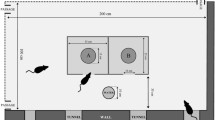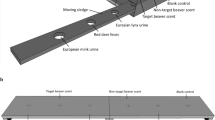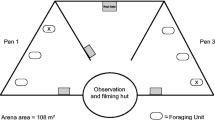Abstract
The alarm pheromones often released by animals under stressful situations seem to elicit behavioral changes in conspecifics, which in the appropriate context can be viewed as anti-predatory responses. However, the releasing of alarm pheromones associated with predatory events has not been demonstrated in mammals. In the current study with wild-caught Cabrera voles, we carried out experiments in the laboratory and in the field to assess the release of alarm pheromones in scent-marks during simulated predatory events and disclose their effects on conspecifics. We first conducted an assay wherein voles where let to scent-mark a clean substrate in the absence of disturbance (control) and under the simulation of predatory events. Contrarily to the control, no fecal boli were released and the area marked with urine was significantly larger during the predatory simulation. In a subsequent assay, we assessed the voles’ preference between urine-marks released under predatory simulation and in control conditions. Voles showed a significant preference by control substrates. Finally, a third assay was carried out in the vole’s habitat wherein the individual activity was monitored by radio-tracking before and after placement of urine-marks obtained during the conditions described above. The vole’s activity was only reduced near the urine-marks released during the simulated predatory events. The results suggest that: (1) during predatory attempts, Cabrera voles release an alarm pheromone in their urine-marks; (2) the putative alarm pheromone reduces the voles’ activity in the surroundings of the marked area; (3) the putative alarm pheromone persists in the field affecting conspecifics’ activity for several days.




Similar content being viewed by others
References
Abel EL (1991) Alarm substance emitted by rats in the forced-swim test is a low volatile pheromone. Physiol Behav 50:723–727. doi:10.1016/0031-9384(91)90009-d
Abel EL (1993) Physiological-effects of alarm chemosignal emitted during the forced swim test. J Chem Ecol 19:2891–2901
Abel EL, Bilitzke PJ (1990) A possible alarm substance in the forced swimming test. Physiol Behav 48:233–239
Ackerl K, Atzmueller M, Grammer K (2002) The scent of fear. Neuroendocrinol Lett 23:79–84
ASAB (2006) Guidelines for the treatment of animals in behavioural research and teaching. Anim Behav 71:245–253
Ashton MC, Paunonen SV, Helmes E, Jackson DN (1998) Kin altruism, reciprocal altruism, and the big five personality factors. Evolut Human Behav 19:243–255. doi:10.1016/s1090-5138(98)00009-9
Blum MS (1969) Alarm pheromones. Annu Rev Entomol 14:57–80. doi:10.1146/annurev.en.14.010169.000421
Boissy A, Terlouw C, Le Neindre P (1998) Presence of cues from stressed conspecifics increases reactivity to aversive events in cattle: evidence for the existence of alarm substances in urine. Physiol Behav 63:489–495
Brown JS, Laundré JW, Gurung M, Laundre JW (1999) The ecology of fear: optimal foraging, game theory, and trophic interactions. J Mammal 80:385–399. doi:10.2307/1383287
Brown GE, Poirier J, Adrian JC (2004) Assessment of local predation risk: the role of subthreshold concentrations of chemical alarm cues. Behav Ecol 15:810–815. doi:10.1093/beheco/arh084
Caro T (2005) Antipredator defenses in birds and mammals. University of Chicago Press, Chicago
Carr WJ, Martorano RD, Krames L (1970) Responses of mice to odors associated with stress. J Comp Physiol Psych 71:223–228. doi:10.1037/h0029164
Chen D, Katdare A, Lucas N (2006) Chemosignals of fear enhance cognitive performance in humans. Chem Senses 31:415–423. doi:10.1093/chemse/bjj046
Cocke R, Moynihan JA, Cohen N, Grota LJ, Ader R (1993) Exposure to conspecific alarm chemosignals alters immune-responses in balb/c mice. Brain Behav Immun 7:36–46
Creel S (1990) How to measure inclusive fitness. P R Soc London 241:229–231. doi:10.1098/rspb.1990.0090
Desjardins C, Maruniak JA, Bronson FH (1973) Social rank in house mice: differentiation revealed by ultraviolet visualization of urinary marking patterns. Science 182:939–941
Eilam D, Dayan T, Ben-Eliyahu S, Schulman I, Shefer G, Hendrie CA (1999) Differential behavioural and hormonal responses of voles and spiny mice to owl calls. Anim Behav 58:1085–1093
Fernandez-Salvador R (1998) Topillo de cabrera, Microtus cabrerae Thomas, 1906. Galemys 10:5–18
Fernandez-Salvador R, Garcia-Perea R, Ventura J (2001) Reproduction and postnatal growth of the cabrera vole, Microtus cabrerae, in captivity. Can J Zool 79:2080–2085
Fernandez-Salvador R, Garcia-Perea R, Ventura J (2005a) Effect of climatic fluctuations on body mass of a Mediterranean vole, Microtus cabrerae. Mamm Biol 70:73–83
Fernandez-Salvador R, Ventura J, Garcia-Perea R (2005b) Breeding patterns and demography of a population of the cabrera vole, Microtus cabrerae. Anim Biol 55:147–161
Figueiredo HF, Bodie BL, Tauchi M, Dolgas CM, Herman JP (2003) Stress integration after acute and chronic predator stress: differential activation of central stress circuitry and sensitization of the hypothalamo-pituitary-adrenocortical axis. Endocrinology 144:5249–5258
Gannon WL, Sikes RS, Mammalogists ACaUCotASo (2007) Guidelines of the American Society of Mammalogists for the use of wild mammals in research. J Mammal 88:809–823
Gray SJ, Hurst JL, Stidworthy R, Smith J, Preston R, MacDougall R (1998) Microhabitat and spatial dispersion of the grassland mouse (Mus spretus Lataste). J Zool 246:299–308
Gutierrez-Garcia AG, Contreras CM, Mendoza-Lopez MR, Garcia-Barradas O, Cruz-Sanchez S (2007) Urine from stressed rats increases immobility in receptor rats forced to swim: role of 2-heptanone. Physiol Behav 91:166–172
Halpern M (1992) Nasal chemical senses in reptiles: structure and function. In: Gans C, Crews D (eds) Biology of the reptilia, physiology E, hormones, brain, and behavior, 2nd edn. University of Chicago Press, Chicago, pp 423–523
Hauser R, Wiergowski M, Marczak M, Karaszewski B, Wodniak-Ochocinska L (2005) Alarm pheromones as an exponent of emotional state shortly before death - Science fiction or a new challenge? Forensic Sci Int 155:226–230
Hauser R et al (2008) A preliminary study for identifying olfactory markers of fear in the rat. Lab Animal 37:76–80
Hemson G, Johnson PJ, South A, Kenward RE, Ripley R, Macdonald D (2005) Are kernels the mustard? Data from global positioning system (GPS) collars suggests problems for kernel home-range analyses with least-squares cross-validation. J Anim Ecol 74:455–463. doi:10.1111/j.1365-2656.2005.00944.x
Hendrie CA, Weiss SM, Eilam D (1998) Behavioural response of wild rodents to the calls of an owl: a comparative study. J Zool 245:439–446. doi:10.1017/S0952836998008073
Hews DK (1988) Alarm response in larval western toads, Bufo boreas: release of larval chemicals by a natural predator and its effect on predator capture efficiency. Anim Behav 36:125–133. doi:10.1016/s0003-3472(88)80255-0
Hollén LI, Radford AN (2009) The development of alarm call behaviour in mammals and birds. Animal Behav 78:791–800. doi:10.1016/j.anbehav.2009.07.021
Hrbáček J (1950) On the flight reaction of tadpoles of the common toad caused by chemical substances. Cell Mol Life Sci 6:100–102. doi:10.1007/bf02153372
Kavaliers M, Choleris E (2001) Antipredator responses and defensive behavior: ecological and ethological approaches for the neurosciences. Neurosci Biobehav R 25:577–586. doi:10.1016/s0149-7634(01)00042-2
Kikusui T, Takigami S, Takeuchi Y, Mori Y (2001) Alarm pheromone enhances stress-induced hyperthermia in rats. Physiol Behav 72:45–50
Kiyokawa Y, Kikusui T, Takeuchi Y, Mori Y (2004a) Alarm pheromones with different functions are released from different regions of the body surface of male rats. Chem Senses 29:35–40. doi:10.1093/chemse/bjh004
Kiyokawa Y, Kikusui T, Takeuchi Y, Mori Y (2004b) Modulatory role of testosterone in alarm pheromone release by male rats. Horm Behav 45:122–127
Kiyokawa Y, Kikusui T, Takeuchi Y, Mori Y (2005) Alarm pheromone that aggravates stress-induced hyperthermia is soluble in water. Chem Senses 30:513–519
Kiyokawa Y, Shimozuru M, Kikusui T, Takeuchi Y, Mori Y (2006) Alarm pheromone increases defensive and risk assessment behaviors in male rats. Physiol Behav 87:383–387
Lawrence B, Smith R (1989) Behavioral response of solitary fathead minnows, Pimephales promelas, to alarm substance. J Chem Ecol 15:209–219. doi:10.1007/bf02027783
Lima SL (1998) Stress and decision making under the risk of predation: recent developments from behavioral, reproductive, and ecological perspectives. In: Møller AP, Milinski M, Slater PJB (eds) Advances in studies of behavior. Academic Press, London, pp 215–290
Lima SL, Dill LM (1990) Behavioral decisions made under the risk of predation: a review and prospectus. Can J Zool 68:619–640. doi:10.1139/z90-092
Lind J, Cresswell W (2005) Determining the fitness consequences of antipredation behavior. Behav Ecol 16:945–956. doi:10.1093/beheco/ari075
Mackaysim A, Laing DG (1981) The sources of odors from stressed rats. Physiol Behav 27:511–513
Mackay-Sim A, Laing DG (1980) Discrimination of odors from stressed rats by non-stressed rats. Physiol Behav 24:699–704. doi:10.1016/0031-9384(80)90400-x
Mathis A, Smith RJF (1992) Avoidance of areas marked with a chemical alarm substance by fathead minnows (Pimephales promelas) in a natural habitat. Can J Zool 70:1473–1476
Mathis A, Smith RJ (1993) Chemical alarm signals increase the survival time of fathead minnows (Pimephales promelas) during encounters with northern pike (Esox Lucius). Behav Ecol 4:260–265. doi:10.1093/beheco/4.3.260
Mathis A, Chivers DP, Smith R (1995) Chemical alarm signals: predator deterrents or predator attractants? Am Nat 145:994–1005
Mira A, Marques CC, Santos SM, Rosario IT, Mathias ML (2008) Environmental determinants of the distribution of the cabrera vole (Microtus cabrerae) in Portugal: implications for conservation. Mamm Biol 73:102–110. doi:10.1016/j.mambio.2006.11.003
Moser JC, Brownlee RC, Silverstein R (1968) Alarm pheromones of the ant Atta texana. J Insect Physiol 14:529–535. doi:10.1016/0022-1910(68)90068-1
Palomo LJ, Gisbert J (2002) Atlas de los mamíferos terrestres de espanã. Dirección general de conservación de la naturaleza. SECEM, SECEMU, Madrid
Pita R, Mira A, Beja P (2006) Conserving the cabrera vole, Microtus cabrerae, in intensively used Mediterranean landscapes. Agr Ecosyst Environ 115:1–5
Pita R, Beja P, Mira A (2007) Spatial population structure of the cabrera vole in Mediterranean farmland: the relative role of patch and matrix effects. Biol Conserv 134:383–392
Pita R, Mira A, Beja P (2010) Spatial segregation of two vole species (Arvicola sapidus and Microtus cabrerae) within habitat patches in a highly fragmented farmland landscape. Eur J Wildlife Res 56:651–662. doi:10.1007/s10344-009-0360-6
Preisser EL, Bolnick DI (2008) The many faces of fear: comparing the pathways and impacts of nonconsumptive predator effects on prey populations. PLoS One 3:e2465. doi:10.1371/journal.pone.0002465
Price EO (1999) Behavioral development in animals undergoing domestication. Appl Anim Behav Sci 65:245–271
Ramos A, Mormède P (1997) Stress and emotionality: a multidimensional and genetic approach. Neurosci Biobehav R 22:33–57. doi:10.1016/s0149-7634(97)00001-8
Rottman SJ, Snowdon CT (1972) Demonstration and analysis of an alarm pheromone in mice. J Comp Physiol Psych 81:483–490
Santos SM, Do Rosario IT, Mathias ML (2005) Microhabitat preference of the cabrera vole in a Mediterranean cork oak woodland of southern Portugal. Vie Milieu 55:53–59
Santos SM, Mathias MDL, Mira A, Simoes MP (2007) Vegetation structure and composition of road verge and meadow sites colonized by cabrera vole (Microtus Cabrerae Thomas). Pol J Ecol 55:481–493
Sherman PW (1977) Nepotism and the evolution of alarm calls. Science 197:1246–1253. doi:10.1126/science.197.4310.1246
Sherman PW (1985) Alarm calls of Belding's ground squirrels to aerial predators: nepotism or self-preservation? Behav Ecol Sociobiol 17:313–323. doi:10.1007/bf00293209
Smith RJF (1986) Evolution of alarm signals: role of benefits of retaining group members or territorial neighbors. Am Nat 128:604–610
Smith J, Hurst JL, Barnard CJ (1994) Comparing behaviour in wild and laboratory strains of the house mouse: levels of comparison and functional inference. Behav Process 32:79–86. doi:10.1016/0376-6357(94)90029-9
Taché Y, Martinez V, Million M, Wang LW (2001) III. Stress-related alterations of gut motor function: role of brain corticotropin-releasing factor receptors. Am J Physiol 280:G173–G177
Taylor RJ, Balph DF, Balph MH (1990) The evolution of alarm calling: a cost–benefit analysis. Animal Behav 39:860–868. doi:10.1016/s0003-3472(05)80950-9
Trivers RL (1971) The evolution of reciprocal altruism. Q Rev Biol 46:35–57
Valenta JG, Rigby MK (1968) Discrimination of the odor of stressed rats. Science 161:599–601
Vieuille-Thomas C, Signoret JP (1992) Pheromonal transmission of an aversive experience in domestic pig. J Chem Ecol 18:1551–1557
Williams GC (1964) Measurement of consociation among fishes and comments on the evolution of schooling. Michigan State University Museum, East Lansing
Williams GC (1992) Natural selection: domains, levels, and challenges. Oxford University Press, Oxford
Wilson EO (1975) Enemy specification in the alarm-recruitment system of an ant. Science 190:798–800. doi:10.1126/science.1198097
Witkin SR, Fitkin MS (1979) Chickadee alarm calls: does mate investment pay dividends? Anim Behav 27:1275–1276
Wu G-M, Boivin G, Brodeur J, Giraldeau L-A, Outreman Y (2010) Altruistic defence behaviours in aphids. BMC Evol Biol 10:1–10. doi:10.1186/1471-2148-10-19
Wyatt TD (2003) Pheromones and animal behaviour: communication by smell and taste. Cambridge University Press, Cambridge
Zalaquett C, Thiessen D (1991) The effects of odors from stressed mice on conspecific behavior. Physiol Behav 50:221–227
Acknowledgments
This study was funded by the Portuguese Foundation for Science and Technology through a PhD grant awarded to LG (SFRH/BD/23699/2005). Further support was provided by a grant awarded to LG by the University of Évora – Programa Bento de Jesus Caraça. Capture and handling of voles were conducted with the permission of the Portuguese nature conservation authority (ICNB). We are grateful to Pedro Salgado for his assistance in field data collection. We are also grateful to Professor Alfredo Pereira for providing access to the space where the laboratory experiments were carried out.
Author information
Authors and Affiliations
Corresponding author
About this article
Cite this article
Gomes, L.A.P., Salgado, P.M.P., Barata, E.N. et al. Alarm scent-marking during predatory attempts in the Cabrera vole (Microtus cabrerae Thomas, 1906). Ecol Res 28, 335–343 (2013). https://doi.org/10.1007/s11284-012-1023-8
Received:
Accepted:
Published:
Issue Date:
DOI: https://doi.org/10.1007/s11284-012-1023-8




